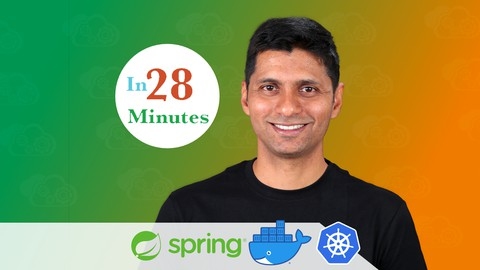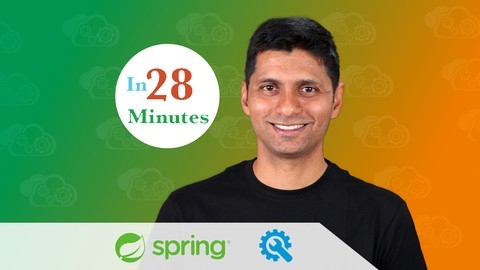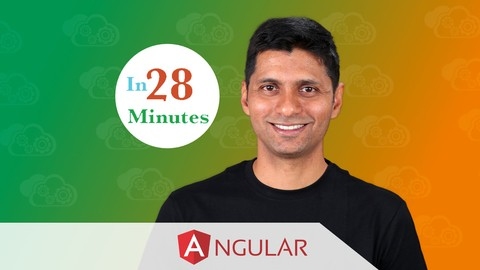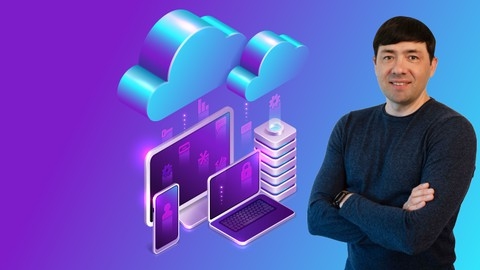Spring Boot is a powerful framework that simplifies Java development, making it easier and faster to build web applications, REST APIs, and microservices.
It offers a robust set of features, including auto-configuration, embedded servers, and starter projects, which help developers focus on business logic rather than boilerplate code.
Learning Spring Boot can open doors to lucrative careers in Java development, empowering you to create scalable and efficient applications.
Finding the right Spring Boot course on Udemy can be a challenging task, with a multitude of options available.
You’re looking for a course that covers both the fundamentals and advanced concepts, provides practical exercises and projects, and is taught by experienced instructors who can guide you through the complexities of this framework.
We’ve carefully analyzed numerous Udemy courses and have concluded that NEW Spring Boot 3, Spring 6 & Hibernate for Beginners is the best overall course.
This course provides a comprehensive introduction to Spring Boot, covering everything from setting up your development environment to building a complete CRUD application with Spring MVC, JPA, and Hibernate.
The instructor’s clear explanations and practical examples make it an ideal choice for both beginners and those seeking to refresh their knowledge.
While this is our top recommendation, Udemy offers a wide variety of Spring Boot courses catering to different learning styles and goals.
Keep reading to explore our recommendations for beginner-friendly introductions, advanced courses focused on specific features like microservices or Spring Security, and courses tailored to specific career paths in Java development.
[NEW] Spring Boot 3, Spring 6 & Hibernate for Beginners
The course starts with a quick introduction to Spring Boot, guiding you through setting up your development environment and creating your first REST controller.
You’ll learn about the Spring Framework, Maven, and explore the project structure and key concepts of Spring Boot.
One of the course’s strengths is its in-depth coverage of core Spring concepts like Inversion of Control and Dependency Injection.
You’ll dive into constructor injection, component scanning, and various injection types, ensuring a solid foundation in Spring’s core principles.
The course then moves on to Hibernate/JPA, teaching you how to perform CRUD operations with databases using Spring Data JPA.
You’ll learn to create REST APIs, handle exceptions, and follow best practices for API design.
Security is a crucial aspect of web development, and this course dedicates a section to securing your REST APIs using Spring Security.
You’ll learn about authentication, authorization, and implementing various security configurations.
Spring MVC is covered extensively, including working with Thymeleaf templates, form data binding, validation, and integrating with CSS.
You’ll build a complete CRUD application using Spring MVC, reinforcing the concepts learned.
The course also dives into advanced Hibernate mappings, covering @OneToOne, @OneToMany, and @ManyToMany relationships.
You’ll learn about fetch types, lazy loading, and how to work with these mappings effectively.
Aspect-Oriented Programming (AOP) is another important topic covered, introducing you to AOP concepts, pointcut expressions, advice types, and integrating AOP with Spring applications.
Throughout the course, you’ll work with practical examples and coding exercises, ensuring you gain hands-on experience with the concepts taught.
The instructor’s clear explanations and step-by-step approach make it easy to follow along and understand the material.
Master Microservices with Spring Boot and Spring Cloud
The course starts by introducing you to web services, including SOAP and RESTful APIs.
You’ll learn how to create RESTful APIs with Spring Boot, covering topics like path variables, exception handling, validations, content negotiation, versioning, filtering, and monitoring APIs.
Once you have a solid understanding of RESTful APIs, the course dives into microservices architecture.
You’ll learn about the challenges and advantages of microservices, as well as key components like service discovery, load balancing, and API gateways.
The course uses Spring Cloud to implement these concepts, guiding you through setting up services like Eureka (naming server), Ribbon (client-side load balancing), Feign (declarative REST clients), and Zuul (API gateway).
The course also covers important aspects like distributed tracing with Zipkin and Spring Cloud Sleuth, fault tolerance with Hystrix, and centralized configuration with Spring Cloud Config Server.
You’ll learn how to connect microservices to databases like H2 and MySQL using JPA and Hibernate.
In the later sections, you’ll explore containerizing microservices with Docker and orchestrating them using Kubernetes on Google Cloud Platform (GCP).
This includes deploying microservices to a Kubernetes cluster, configuring service discovery, centralized logging, monitoring, liveness and readiness probes, and autoscaling.
Throughout the course, you’ll work on practical examples and exercises, ensuring you gain hands-on experience with the concepts covered.
The instructor also provides debugging tips and best practices for working with microservices.
Java Spring Framework 6 with Spring Boot 3
The course starts with a solid foundation in Java, covering essentials like variables, data types, operators, loops, and object-oriented programming concepts.
This ensures that you have a strong grasp of the language before diving into the Spring Framework.
Once you’ve mastered the Java fundamentals, the course introduces you to the Spring Framework and Spring Boot.
You’ll learn about the core principles of Spring, such as Inversion of Control (IoC) and Dependency Injection (DI), and how they simplify application development.
The course also covers various Spring modules, including Spring MVC for web development, Spring Data JPA for database integration, and Spring Security for securing your applications.
One of the standout features of this course is its practical approach.
You’ll work on several projects throughout the course, allowing you to apply what you’ve learned in real-world scenarios.
For instance, you’ll build a job application web app, a quiz app using microservices, and even explore data structures and algorithms (DSA) concepts.
The course also covers advanced topics like Spring AOP (Aspect-Oriented Programming), Docker containerization, and microservices architecture.
These topics are essential for building scalable, maintainable, and robust applications in modern software development.
Throughout the course, you’ll gain hands-on experience with popular tools and technologies like Maven, PostgreSQL, MySQL, React, and Postman.
The instructor provides clear explanations and practical examples, making it easier to understand and apply the concepts.
One notable aspect of this course is its emphasis on staying up-to-date with the latest versions of Spring Framework and Spring Boot.
By covering Spring Framework 6 and Spring Boot 3, you’ll be learning the most recent features and best practices, ensuring that your skills are relevant and in demand.
Learn Spring Boot 3 in 100 Steps - No 1 Java Framework
The course starts with an introduction to Spring Boot, covering its goals and how it simplifies Java development.
You’ll learn about Spring Boot’s magic - starter projects and auto-configuration - which make development faster and more efficient.
Next, you’ll dive into building a web application with Spring Boot.
You’ll create a Spring MVC controller, work with JSPs, handle query parameters, and integrate with databases like H2 and MySQL.
The course also covers essential topics like logging, Bootstrap CSS framework integration, and Spring Security setup.
Moving on, you’ll learn about unit testing with JUnit and mocking with Mockito, which are crucial for writing robust code.
The course also provides an introduction to build tools like Maven and Gradle, helping you understand project setup and management.
One of the highlights is the in-depth section on building a REST API with Spring Boot.
You’ll learn about REST principles, create APIs for handling surveys and questions, integrate with a database using Spring Data JPA, and write integration and unit tests for the APIs.
Spring Security is also covered for securing the REST APIs.
Additionally, the course includes appendices that introduce you to the Spring Framework, JPA with Spring Boot, and functional programming in Java - valuable topics for any Java developer.
Throughout the course, you’ll find hands-on coding exercises, step-by-step guides, and best practices for writing clean, maintainable code.
The instructor’s clear explanations and real-world examples make it easy to understand and apply the concepts.
Master Java Web Services and REST API with Spring Boot
The course starts with an introduction to web services, covering key concepts like SOAP and RESTful services, their differences, and important terminology.
This lays a solid foundation for the rest of the course.
Next, you’ll dive into the Spring Framework, learning about its core concepts like dependency injection, loose coupling, and exploring different modules and projects.
This section provides a comprehensive understanding of the framework before moving on to Spring Boot.
The Spring Boot section is extensive, covering everything from setting up a new project to understanding auto-configuration, starter projects, and production-ready features like profiles, embedded servers, and actuators.
You’ll also learn how to build faster with DevTools and the differences between Spring Boot, Spring, and Spring MVC.
The course then covers build tools like Maven and Gradle, giving you hands-on experience with creating and managing Spring Boot projects using these tools.
Moving on, you’ll learn to build SOAP web services using a contract-first approach, including defining XML schemas, configuring endpoints, and implementing security with WS-Security.
This section also covers JAXB and working with WSDL files.
The RESTful web services section is comprehensive, starting with creating a basic REST API and then covering advanced topics like exception handling, validations, content negotiation, versioning, HATEOAS, filtering, and monitoring with actuators.
You’ll also learn about Open API specification and auto-generating Swagger documentation.
The course then dives into JPA and Hibernate, teaching you how to connect your RESTful web service to databases like H2 and MySQL.
You’ll learn about Spring Data JPA, querying data, and implementing authentication with Spring Security.
Additionally, the course covers best practices for RESTful web services, including the Richardson Maturity Model.
As a bonus, there’s an introduction to functional programming in Java, covering concepts like streams, filters, lambdas, and the Optional class.
Throughout the course, you’ll work on hands-on exercises and projects, reinforcing the concepts you’ve learned.
The instructor provides code backups and step-by-step changes for reference.
Master Hibernate and JPA with Spring Boot in 100 Steps
You’ll start with a gentle introduction to Spring Boot, covering essentials like setting up projects, building APIs, understanding auto-configuration, and leveraging developer tools.
This lays the groundwork for the main course content.
The course then dives deep into the transition from JDBC to JPA, guiding you step-by-step.
You’ll learn to work with databases like H2, write queries, and map data to Java objects elegantly using JPA annotations.
Before going further with JPA, you’ll get a solid grounding in unit testing with JUnit.
This ensures you can write robust, testable code as you explore advanced JPA concepts like relationships (OneToOne, OneToMany, ManyToMany), inheritance mappings, and queries (JPQL, Criteria).
Transaction management, an often overlooked but crucial aspect, is covered in depth, including ACID properties, isolation levels, and implementation strategies.
As you progress, you’ll leverage powerful tools like Spring Data JPA for simplified data access and Spring Data REST for building hypermedia-driven RESTful repositories.
The course doesn’t stop there - it dives into performance tuning tips for Hibernate/JPA, caching strategies, soft deletes, and integrating with embedded objects and enums.
You’ll also learn good practices for designing great JPA applications.
Throughout the course, you’ll have access to FAQ videos addressing common queries, like connecting to different databases, choosing between JPA and JDBC, and general best practices.
If you’re new to Spring, there’s even a bonus section introducing the Spring framework, covering core concepts like dependency injection, loose coupling, and exploring Spring projects/modules.
Go Java Full Stack with Spring Boot and Angular
You’ll start by gaining a solid understanding of JavaScript, TypeScript, and Angular, the popular front-end framework.
The course walks you through creating an Angular application from scratch, exploring its components, data binding, routing, and more.
Moving on, you’ll dive into the world of RESTful web services and learn how to design and implement them using Spring Boot.
You’ll build REST APIs, connect them to the Angular front-end, and integrate features like basic authentication and JSON Web Tokens (JWT) for secure communication.
It covers integrating Spring Boot with JPA (Java Persistence API) and Hibernate for seamless database operations.
You’ll learn to map Java objects to database tables, perform CRUD (Create, Read, Update, Delete) operations, and leverage the power of Spring Data JPA.
The course also delves into securing your Spring Boot applications with Spring Security.
You’ll explore various security principles, authentication mechanisms (form-based, basic, JWT), authorization, and even integrate with external authentication providers like Google using OAuth2.
Throughout the journey, you’ll gain hands-on experience by building a full-fledged Todo application, complete with features like user authentication, CRUD operations for todos, and a polished user interface using Angular and Bootstrap.
The course is designed to be practical and engaging, with each step building upon the previous one.
You’ll not only learn the theoretical concepts but also apply them immediately through coding exercises and projects.
The instructor provides clear explanations, best practices, and troubleshooting tips to ensure you have a smooth learning experience.
Full Stack: Angular and Java Spring Boot E-Commerce Website
This course covers building a full-stack e-commerce application from scratch using Angular for the front-end and Spring Boot for the back-end.
It starts with crash courses on TypeScript and Angular fundamentals, ensuring you have a solid foundation.
You’ll learn how to set up development tools, create components, integrate Bootstrap CSS, and handle conditionals and formatting in Angular.
Moving on, you’ll dive into developing the Spring Boot back-end, covering JPA entities, REST APIs, and database integration.
The course guides you through building the Angular front-end, including features like product listing, searching, pagination, and shopping cart functionality.
As you progress, you’ll integrate an online shop template, add support for categories and keyword searches, and implement a master-detail view for products.
The course also covers crucial aspects like checkout form validation, saving orders to the database, and securing the application with authentication and authorization using Okta.
Additionally, you’ll learn how to handle browser refreshes, refactor the codebase, implement order history, secure communication with HTTPS, configure environments in Angular, and integrate credit card payment processing with Stripe.
The instructor provides clear explanations, coding examples, and hands-on exercises to reinforce the concepts.
You’ll have access to the source code and PDF files for reference.
Spring Boot Microservices and Spring Cloud. Build & Deploy.
The course starts with an introduction to microservices and Spring Boot, covering essential concepts like RESTful web services, HTTP methods, headers, and testing with Postman.
You’ll learn to set up your development environment with Java, Spring Tool Suite, and create your first Spring Boot project.
It then dives into building microservices using Spring Boot, starting with a quick intro to RESTful web services.
You’ll create user and account management microservices, learn to enable Eureka for service discovery, and use the Spring Cloud API Gateway (formerly Zuul) for routing requests.
The course covers important microservices patterns like client-side load balancing, circuit breakers (Hystrix and Resilience4j), retries, and distributed tracing with Micrometer and Zipkin.
You’ll also learn about centralized configuration with Spring Cloud Config Server using Git and file system backends.
Logging and monitoring are crucial aspects covered through Spring Boot Actuator, aggregating logs with the ELK (Elasticsearch, Logstash, Kibana) stack, and securing the Eureka dashboard.
The course teaches you to run microservices in Docker containers on AWS EC2, handling multiple environments (dev, prod), and downstream service authorization.
An important topic is role-based access control (RBAC) in microservices, covering authentication, authorization, roles, authorities, and JSON Web Tokens (JWT).
You’ll learn to implement RBAC at the microservice and API Gateway levels.
The course also covers Eureka server clustering for high availability and ends with a bonus lecture on what’s next.
Throughout the course, you’ll work with hands-on examples, source code, and practice exercises to reinforce the concepts.
The instructor provides clear explanations and maintains a conversational tone while incorporating the necessary technical details.
Spring Boot Fundamentals
The course starts by introducing you to Spring Boot and its features, guiding you through setting up the necessary software like Java, Spring Tool Suite (STS), MySQL, and Postman.
You’ll learn how to create your first Spring Boot project and understand core concepts like dependency injection and testing.
Moving forward, you’ll dive into Spring Data JPA for database operations and build a complete CRUD REST API.
The course covers creating a REST client using RestTemplate and explores profiles for configuring different environments.
You’ll also learn about logging, health checks, metrics, and Spring Security integration.
The syllabus covers templating with Thymeleaf, allowing you to create dynamic web pages.
Database caching is introduced to improve application performance.
You’ll gain hands-on experience with Spring Batch for batch processing and learn how to write unit tests using MockMvc.
The course delves into messaging with Spring JMS, teaching you how to work with message brokers like Apache ActiveMQ.
You’ll learn to document your REST APIs using Swagger and implement validations.
File upload and download functionality is also covered.
A real-world library management use case walks you through building a complete application, covering various aspects like models, repositories, services, and borrowing/returning books.
The course explores reactive programming with Spring WebFlux, teaching you to work with Mono and Flux.
You’ll learn to use reactive MongoDB and write reactive tests.
Finally, you’ll dive into RSocket, a protocol for use cases like streaming data and real-time communication.
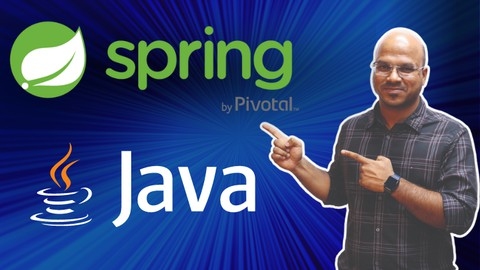
![[NEW] Spring Boot 3, Spring 6 & Hibernate for Beginners](/img/best-spring-boot-courses-udemy/647428_NEWSpringBoot3Spring6HibernateforBeginners.jpg)
